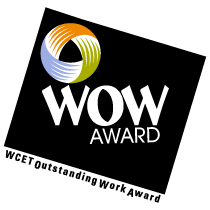Personalized Adaptive Learning in Algebra-Based Introductory Physics Courses at the University of Central Florida
Published by: WCET | 5/4/2023
Tags: Adaptive/Personalized Learning, Managing Digital Learning, Online Learning, WCET Awards, WOW Award
Published by: WCET | 5/4/2023
Tags: Adaptive/Personalized Learning, Managing Digital Learning, Online Learning, WCET Awards, WOW Award

As we start our new awards season here at WCET, we’re thrilled to continue to feature our previous honorable mentions for the 2022 WOW Award. Our judges were so impressed by this project and the inspiration the team showed that we wanted to honor their work. Thank you to Archana, Baiyun, and Joseph for sharing your experiences with us!
As I mentioned, the 2023 awards season has recently started. Read today’s post and then visit our awards page to learn more about this year’s WOW Award nominations!
Enjoy the read,
Lindsey Downs, WCET
At the University of Central Florida, we have strategically implemented Personalized Adaptive Learning (PAL) courseware to enhance student success in large-enrollment algebra-based College Physics courses. These foundation courses are taught in studio- and lecture-mode format, which traditionally have high DFW (D or F grade, Withdrawal) rates. Powered by the Realizeit Adaptive Intelligent Engine, the PAL course is designed to address individual student learning preferences, identify those at risk in real-time, provide flexibility, offer unique pathways through the course material, and adjust media presentations and concepts based on individual student skills and preferences. By customizing the courseware to meet individual student needs, we aim to improve student engagement and promote academic success.
Collaborating with instructional designers and programmers, Dr. Archana Dubey spearheaded a course redesign initiative aimed at transforming algebra-based introductory physics courses. The College Physics pathway consists of two courses, College Physics I (PHY2053) and College Physics II (PHY2054), which are offered primarily for students majoring in information technology, the biological sciences, and pre-health professions. Several students taking these courses plan to take the medical college admission test. Approximately 4,500 students take these courses each year. Post redesign and over the past three years, we have observed:
These outcomes are a result of using the PAL strategy. This transformation has resulted in significant positive impacts on the students, ensuring they receive a quality education that prepares them for their future academic and professional pursuits.
To understand more about how powerful these changes have been, we’ll review some of the adjustments made to introductory Physics courses.
In the course pathway design process, Dr. Dubey:

The PAL assignments for the College Physics pathway courses are structured as focused lessons that interrelate prerequisite and remediation relations. Once opened, these assignments are available to the students to work on until the day of the final exam, which helps students to progress at their own pace and on their own time. To encourage fearless perseverance, students are allowed multiple-attempts and submissions. The highest score is what counts as the final grade. This motivates students to improve their scores, which improves their learning as well.
Every time a student logs in to work on an assignment, the system selects questions from the question bank designed by the instructor especially for that section. This means that the students work on variety of problems and concept questions that are relevant for their specific class and section. The numerical values in the problems are randomized and the questions are in multiple-choice and ‘enter the answer’ formats. The multiple-choice problems have eight answer choices. Students have the option to flag questions they struggle with, and the ‘instructor feedback’ option facilitates timely intervention. Additionally, the just-in-time instructor dashboard helps the instructor address student questions, customize in-person lectures accordingly, and provide personalized remediation or accelerated interventions. This approach enables students to receive timely and targeted support, which helps to improve their learning outcomes and overall academic success.
The redesigned adaptive College Physics I course has been delivered to students since the fall of 2019. Since the initial implementation of PHY2053, Dr. Dubey has evaluated students’ learning outcomes and made enhancements to address students’ difficulties.

For instance, videos and Physics Education Technology (PhET) simulations have been incorporated to provide students with interactive visual aids that can help clarify concepts. Students often struggle to solve problems where they have to follow a number of steps to get the answer. Hence, step-by-step interactive example problems have been created to guide students through problem-solving process. In these examples, students answer a sequence of questions designed to reinforce problem-solving strategies. Additional graphing questions (Figure 2) have been added to help students practice their understanding of vectors, which has resulted in a continuous improvement in their learning. These enhancements have been well-received by students, who report a better understanding of the material and an increased ability to apply what they have learned to solve physics problems.
The College Physics II course, PHY2054, was launched in fall 2022. In this course, students receive individualized remediation lessons from PHY2053 based on their performance. This approach allows students to review and reinforce concepts from the previous course to better prepare them for more advanced material. The personalized approach to learning, coupled with the incorporation of new instructional materials, has led to significant improvements in students’ understanding of physics and their academic success.
Here at UCF, we’re so proud that our personalized approach has led to these improvements and successes. We believe that this type of course redesign can be beneficial for many types of courses and institutions.
Senior Lecturer, UCF Department of Physics, University of Central Florida
Senior Instructional Designer at the Center for Distributed Learning , University of Central Florida
Instructional Designer, Center for Distributed Learning, University of Central Florida